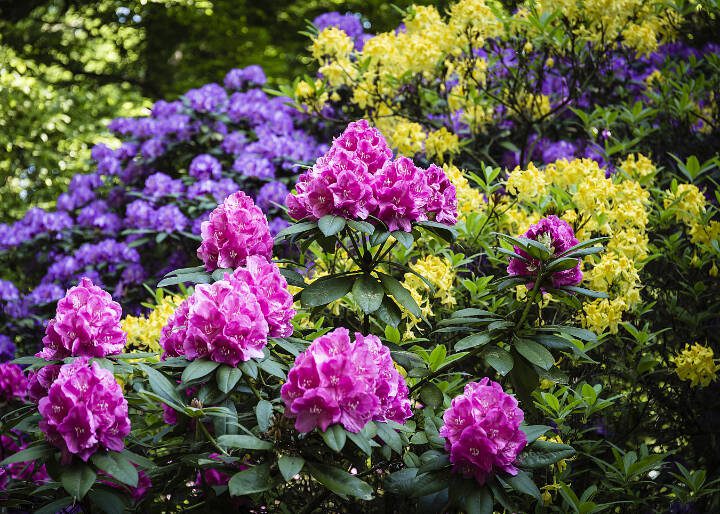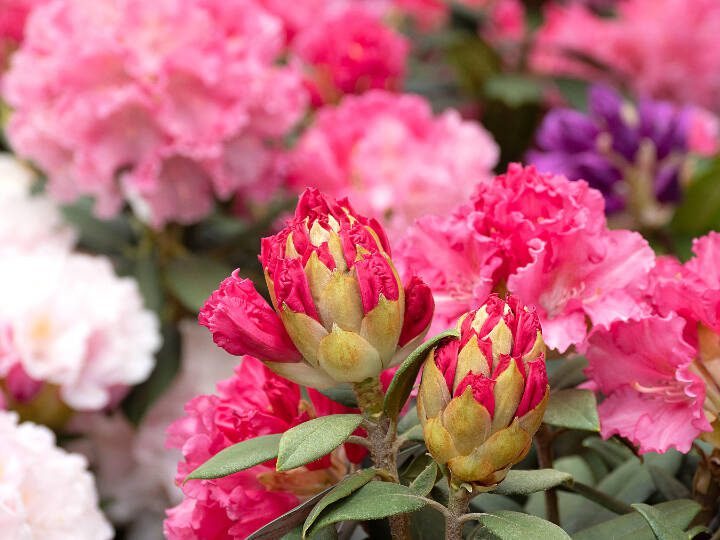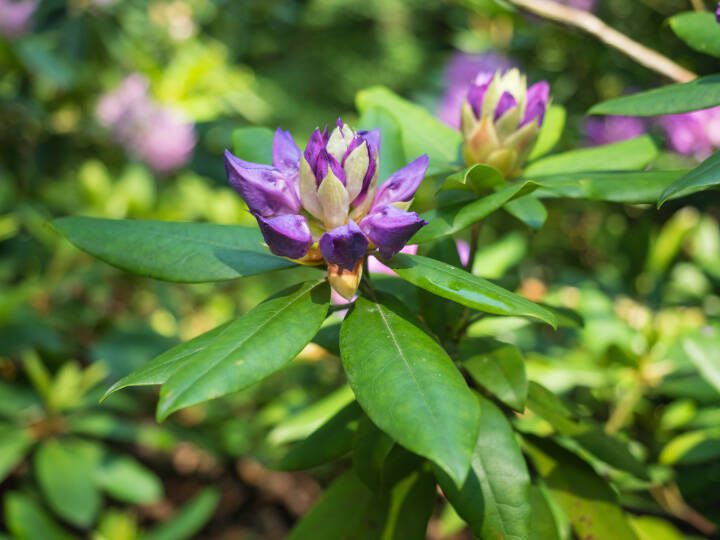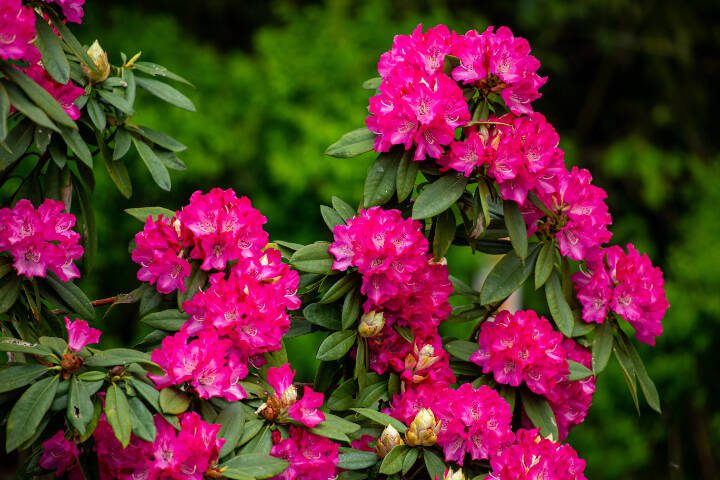By Trevor Cameron / The Golfing Gardener
For generations of gardeners, and certainly for me, rhododendrons represent the arrival of spring in our local landscapes. Everywhere you go this time of year, there is a stunning rhododendron in full bloom to catch your eye.
These flowering beauties come in all sorts of shapes, sizes and colors, and thrive in our climate when located and planted correctly. The choices of cultivars are truly endless, with more than 5,000 registered varieties — some growing tall while others small, and some blooming as early as February while others as late as June.
While some may be hard to find, the “stock” varieties available at most local nurseries work beautifully, representing a good mix of useful, old-school flavors with some newer, more modern options. Pacific rhododendron (R. macrophyllum) is our Pacific Northwest native species, but other really cool species and hybrids with fun foliage and flowers can be found and grown successfully in our gardens, as well.
Let us begin on the smaller side and consider some of the excellent dwarf varieties. Rhododendrons don’t have to be the size of your garage or bury the garden with age, as there are plenty of smaller growers out there. Many gardeners mistake these for azaleas as they have similarly sized foliage, but most dwarf rhododendrons are more sun tolerant, cold hardy and perhaps even more durable than azaleas.
I have used many in my own garden in a sunny, south-facing rockery, while others I have placed in locations with a little more afternoon shade. It is so nice to come home and see these in bloom right now — low growing little mounds full of color. If you look, you can find almost any flower color in a dwarf option, staying under 2 feet tall and spreading a little wider. Many other compact options that stay under 4 feet tall, are out there, too, and can be used as foundation plants or tidier specimens for smaller garden locations.
All rhododendrons will thrive in a part-sun/part-shade woodland garden location, but deep shade and full afternoon sun are two extremes we need to be a little more careful with. Many gardeners complain about their leggy, spindly old specimens, while others see their plants get sunburned every August in the heat. Often, these plants were put in bad locations to begin with, where a different, better-suited variety would thrive.
While there is no steadfast rule, a couple generalizations will help when making your choices. Larger foliage typically means plant in part- to full-shade locations, while smaller leaves (such as the dwarfs mentioned above) tolerate much more afternoon sun. The other factor is flower color, and again there are some exceptions, but generally reds, purples and some pinks will take more sun, while lighter pinks, yellows, oranges and whites prefer shade in the afternoon.
Rhododendrons are acid-loving, so they should be planted using an acidic compost as an amendment along with some mulch over their roots (but not up onto their crowns). Feeding them a couple times a year will keep them looking prime with lush green foliage and optimal annual growth. I always try to feed mine once in March or April with a granular organic rhododendron food, then repeat again in June to help over the summer. One great trick I picked up a few years back is using a product called Ultra Bloom from E.B. Stone Organics, in addition to regular rhododendron food. This product is all about phosphorous and potassium and contains no nitrogen — the perfect supplement to increase bud set and thus bloom count exponentially for the coming spring.
As all rhododendrons are old-wood bloomers, remember to “prune after bloom.” Because buds are set in summer, any summer/fall/winter/early spring pruning will cut buds off and reduce flowering the next spring. The perfect time to cut plants back to reduce size is right after they are done blooming, after which you should feed them. This will result in a superior, compact plant with maximum flower power the following spring.
We should also consider the yearly chore of deadheading. To deadhead or not to deadhead? (A common question at the garden center, for sure.) My OCD side says yes, and I often do my shorter growing varieties, especially when they are young and manageable. Do I climb up and deadhead the 12-foot-tall one in my front yard? Of course not! It is ultimately up to you, as this is not a necessary chore. I always bring this up when discussing pruning: Remember that if you prune back a bit after bloom, you essentially get your deadheading done at the same time.
I was planning on listing out a hundred of my favorite cultivars, but in all honesty, everyone has different affinities for foliage and flower. If you explore your options, you will find many suitable candidates for your specific tastes. Look for eye-catching foliage, as well; Some variegated options can be found, and indumentum on Yak type rhododendrons (R. yakushimanum cvs.), adding interesting leaves for shady garden with morning sun.
I cannot resist mentioning some specific hybrids with excellent flowers that can be found now. A few newer introductions that offer unusual bloom colors are Pomegranate Splash (fuchsia/white), Seaview Sunset (orange/yellow), Cherry Cheesecake (white/pink), Neon (orange/yellow), Hachmann’s Picobello (white/purple), Honey Butter (yellow/orange), and Melrose Flash (white/pink). Mix these with some classic options such as Jean Marie (red), Taurus (red), Hotei (yellow), Nancy Evans (yellow), Calsap (white/purple), Chinoides (white), Anna Rose Whitney (pink), Hachmann’s Polaris (purple), Purple Splendour (purple) and Cosmopolitan (pink), and you have yourself an outstanding spring flower show from March through May.
Free classes
Sunnyside Nursery in Marysville will host “Rockin’ Rhodies & Azaleas” at 10 a.m. on Saturday, April 27, followed by the annual Rhododendron Truss Show from 10 a.m. to 2 p.m., and “Successful Shade Gardens” at 10 a.m. on Sunday, April 28. For more information or to sign up, go to www.sunnysidenursery.net/classes.
Trevor Cameron is a certified professional horticulturist (CPH) and serves as general manager for Sunnyside Nursery in Marysville. He can be reached at sunnysidenursery@msn.com.
Talk to us
> Give us your news tips.
> Send us a letter to the editor.
> More Herald contact information.




























